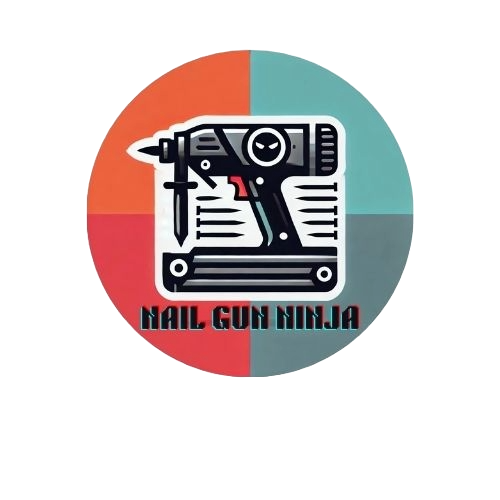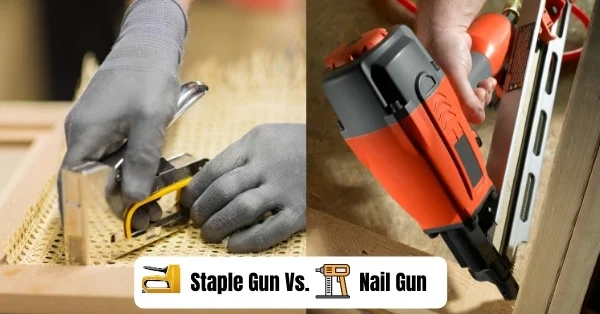Regarding fastening materials, a nail gun and a staple gun are both great tools for the job. Continue reading this article if you want to get enlightened about this very intriguing discussion on – nail gun vs staple gun.
Which one should you choose? Nail guns and staple guns have different advantages and disadvantages depending on the type of project you’re working on.
The most important difference is that nail guns use nails while staple guns use staples. Both tools join two pieces of material together, but each serves distinct purposes and performs best in different applications.
What is a Nail Gun?
A nail gun is also known as a nailer. It is a powerful tool used to drive nails into materials like wood, metal, and sometimes concrete.
It’s a great tool for improving efficiency and speed. This tool is perfect for jobs such as framing, carpentry, and more.
Whether you’re working on a new deck, building a house, or putting together furniture, a nail gun helps you get the job done faster and with less effort.
Pros and Cons of Nail Guns
Pros
- Speed and Efficiency: Nail guns drive nails quickly. They are perfect for saving time on larger projects.
- Strength: Nails provide a stronger hold than staples. Nail guns are ideal for framing and structural tasks.
- Variety: Nail guns come in different types such as finish or framing.
- Versatility: The types and models come with enough versatility for many uses.
Cons
- Weight and Size: Especially pneumatic or framing nailers are bulky and heavy. This can make them harder to control for some tasks.
- Complexity: Some models need extra equipment like an air compressor.
- Maintenance: Some nail guns require regular maintenance.
Nail Gun – Its Features and Uses
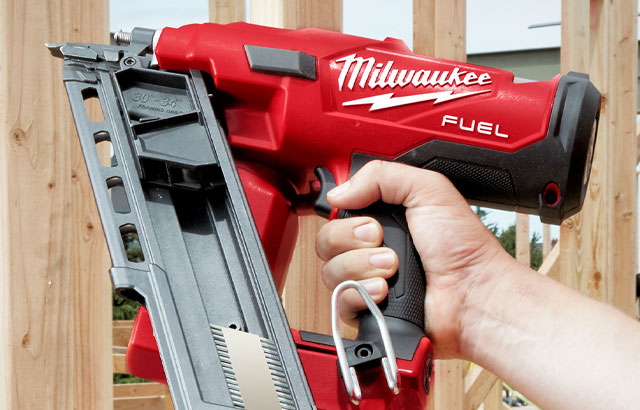
Power Source Options
Nail guns come in three main power types—pneumatic (air-powered), electric, and battery powered.
Pneumatic nail guns are the most powerful and commonly used nail gun type. In contrast, electric and battery powered models offer portability and convenience for remote users.
Versatility in Nail Sizes
Nail guns come with a wide range of nail sizes. They can accommodate different types of nail sizes based on their specifications.
For example, from small brad nails for delicate trim work to large framing nails for heavy duty construction. This versatility allows you to tackle everything from finishing touches to structural projects with a single tool.
Firing Mechanisms
Most nail guns feature adjustable firing mechanisms. They are sequential or bump firing. Sequential firing requires you to press the safety tip and pull the trigger for each nail. This function offers precision and safety.
In contrast, the bump firing mechanism allows you to hold down the trigger and rapidly fire nails by bumping the tool against the surface. If you working on a high speed task then you may use this mechanism.
What is a Staple Gun?
A staple gun is a tool used to insert metal staples into thin materials like fabric, upholstery, insulation, and thin wood.
These guns are usually lightweight, portable, and easy to handle. They are ideal for smaller tasks around the house or in a workshop.
Pros and Cons of Staple Guns
Pros
- Lightweight and Easy to Use: Staple guns are compact and easy to handle. They are great for smaller and more delicate tasks.
- Versatile for Soft Materials: They work well for upholstery, crafting, and stapling fabric to wood or other surfaces.
- Affordable: Staple guns are generally cheaper than nail guns.
- DIY Friendly: These guns are a good choice for casual DIY projects or lightweight home improvement tasks.
Cons
- Limited Strength: Staples can hold things together. But they can not deliver the same strength as nails.
- Unsuitable for Heavy Duty Jobs: They aren’t suitable for heavy duty projects.
- Not Ideal for Woodworking: Staple guns have trouble with thicker or tougher materials like solid wood.
- Less Durability: Staples are less durable than nail gun nails.
Staple Gun – Its Features and Uses
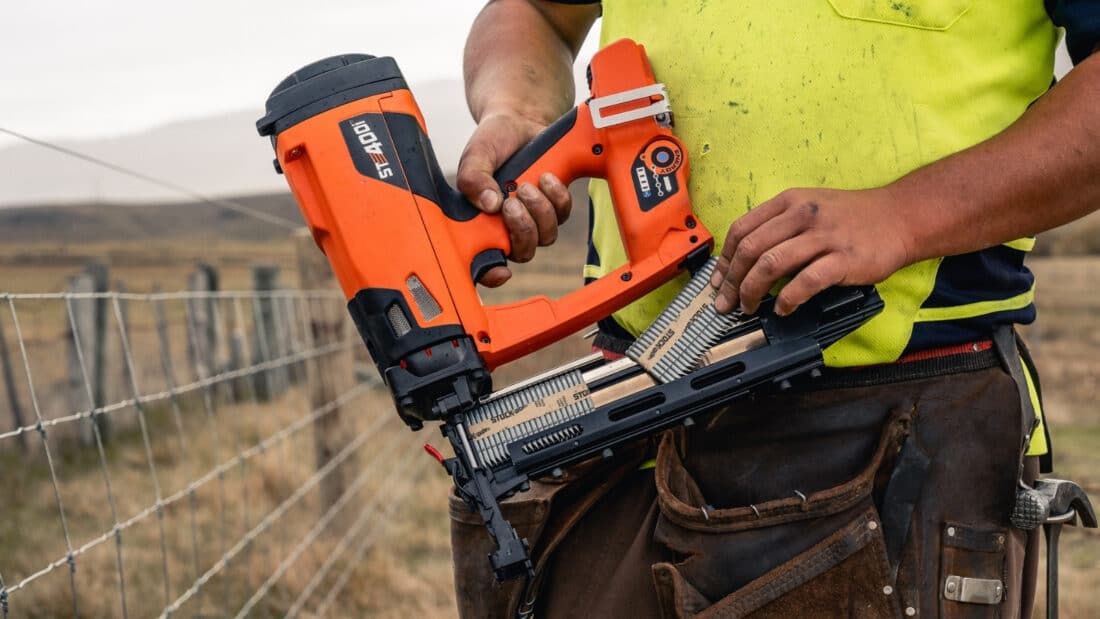
Lightweight & Portable Design
Staple guns are typically compact and easy to handle. They are perfect for tasks that require precision and mobility.
Whether you’re working on upholstery, insulation, or crafting, their lightweight nature ensures you work comfortably for extended periods.
Variety of Staple Sizes
Staple guns can accommodate a range of staple sizes. Their size can range from narrow 1/4 inch staples for delicate fabrics to wider 1/2-inch staples for securing insulation or wiring.
This flexibility allows you to tackle a variety of projects with just one tool.
Power Options
Staple guns come in manual, electric, and pneumatic models. Manual staple guns are ideal for small, quick fixes.
In contrast, electric and pneumatic models offer more power and efficiency for larger or repetitive tasks. This variety ensures there is a staple gun suited to your specific needs.
Nail Gun vs Staple Gun – Key Differences
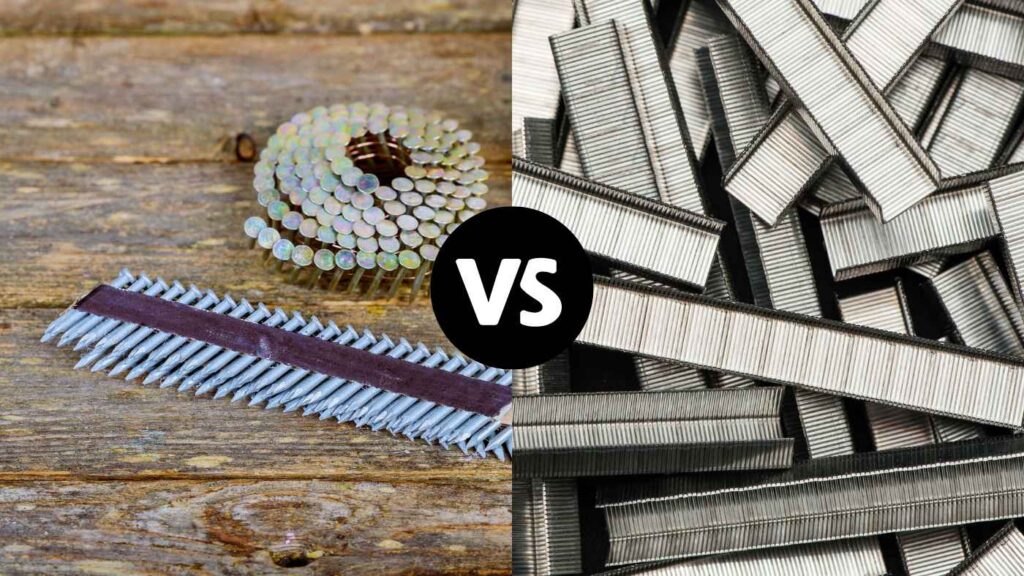
Choosing between a nail gun and a staple gun depends on the project you’re working on. While both tools are used for fastening, they have different strengths and applications.
Here is the list of key differences of these two tools:
Fastener Type & Strength
- Nail Guns: Use long and slender nails that go deep into materials. They provide a strong and durable hold. Nailers are ideal for structural tasks like framing, trim work, and carpentry.
- Staple Guns: Use U-shaped staples that grip surfaces well. However, they don’t have strong holding power like nails. They are best for securing fabric, insulation, and lightweight wood panels.
Power Source & Operation
- Nail Guns: Can be pneumatic (air-powered), battery-operated, or electric. Pneumatic versions are the most powerful. Battery and electric models offer more convenience.
- Staple Guns: Available in manual, electric, and pneumatic options. Manual staple guns require hand force. In contrast, electric and pneumatic ones are faster and more powerful.
Best for Different Materials
- Nail Guns: Work well with wood, metal, and even concrete materials. Perfect for framing, flooring, fencing, and roofing.
- Staple Guns: Best for soft materials like fabric, upholstery, insulation, and carpets. Ideal for crafts, furniture repairs, and fastening lightweight materials.
Holding Power and Durability
- Nail Guns: Provide a stronger, longer-lasting hold. They are essential for load-bearing structures.
- Staple Guns: Offer a wide but shallow grip. Staple guns are good for securing sheets and fabrics but not for heavy duty projects.
Precision and Versatility
- Nail Guns: Designed for deep and precise penetration with minimal visibility. They are great for clean finishes in woodworking.
- Staple Guns: More versatile for delicate materials. Perfect for household repairs and crafts.
Ease of Use
- Nail Guns: Require some skill and practice. Misfires and jams can occur. Improper use of this tool can be dangerous.
- Staple Guns: Easier to handle, especially manual and electric models. Great for beginners and DIYers.
Safety Considerations
- Nail Guns: Can be hazardous due to high power and deep penetration. Always wear safety gear.
- Staple Guns: Safer, but high powered pneumatic models can still cause minor injuries if misused.
Cost and Budget
- Nail Guns: More expensive than staple guns due to advanced features and power. Prices vary depending on types and models.
- Staple Guns: Generally more affordable with manual models being the cheapest option.
Weight and Portability
- Nail Guns: Pneumatic nail guns are lightweight without any air compressor. But along with an air compressor, they become heavier. Cordless nailers become heavier when you insert a battery into them.
- Staple Guns: Lighter and easier to maneuver with manual versions weighing 1–2 lbs. Electric and pneumatic staple guns are slightly heavier but remain more portable than most nail guns.
Noise level
- Nail Guns: Pneumatic model nail guns produce much more noise. They produce a sharp burst of compressed air with each shot. Noise levels can reach 85–100 dB.
- Staple Guns: Particularly manual and electric models are quieter. Pneumatic staple guns are louder but generally produce less noise than nail guns.
Fastener Removal
- Nail Guns: Nails are harder to remove from materials if they have fully penetrated the material. You need pliers or a nail puller to remove them.
- Staple Guns: Staples are easy to remove from the materials. You just need a lightweight staple remover for office paper staples. Use pliers in the case of deep materials.
Learning Curve
- Nail Guns: Require some experience to use safely and effectively. Misuse can cause misfires, jamming, or even injuries.
- Staple Guns: Easier to handle, especially manual and electric models. They are 100% beginner friendly. They are common in household applications and light duty projects.
Staple Gun vs Nail Gun – At a Glance
| Feature | Nail Gun | Staple Gun |
| Fastener Type & Strength | Uses long, slender nails for strong, durable hold | Uses U-shaped staples, weaker holding power |
| Power Source & Operation | Pneumatic (air-powered), battery-operated, electric | Manual, electric, pneumatic options |
| Best for Different Materials | Works with wood, metal, concrete | Best for soft materials (fabric, insulation, crafts) |
| Holding Power and Durability | Strong, long-lasting hold for load-bearing structures | Shallow grip, suitable for light-duty task |
| Precision and Versatility | Deep, precise penetration | Versatile for delicate materials and household repairs |
| Ease of Use | Requires skill and practice | Easy to handle |
| Safety Considerations | High risk, requires safety gear | Safer, but can cause injuries |
| Cost and Budget | More expensive | More affordable |
| Weight and Portability | Heavier | Lighter |
| Noise Level | Noisy (85-100 dB) for pneumatic models | Quieter |
| Learning Curve | Requires experience | Easy for beginners, no complex |
Nailers and Staplers Mechanisms
Both nailers and staplers are great for their specific applications but it is important to understand the differences in how they work. Let’s take a look at the mechanisms of nail guns and staple guns.
Nail Gun Mechanism
A nail gun uses different power sources like air, electricity, or gas to drive nails into materials.
Here’s a simple view of how a nail gun works:
How It Works
- Trigger: When you pull the trigger it will activate a valve that lets air or gas into the mechanism.
- Driver Blade or Piston: The air or gas pushes a piston or driver blade inside the gun. It drives the nail down the barrel of the gun.
- Nail Delivery: Nails are loaded into the magazine of the gun through a spring or gravity system. When the driver hits the nail, it’s driven into the material.
- Exhaust Valve: After firing the nail, the air or gas is released. Then the gun resets to be prepared for the next shot.
Stapler Mechanism
Staplers are similar in design to nail guns, but they’re made for driving staples. They come in different shapes and mechanisms.
Here’s a simple view of how a staple gun works:
How It Works
- Trigger or Handle Mechanism: For manual staplers, squeezing the handles releases a spring loaded mechanism. For electric or pneumatic staplers, pulling the trigger activates the power source to drive the staples.
- Staple Loading: Staples are loaded into the stapler’s magazine, where they’re ready for use.
- Driver Blade or Piston: The driver pushes the staple into the material by bending the legs of the staple around the edges to hold the material together.
- Staple Delivery: After the staple is driven into the material the stapler resets. Then it gets ready to fire the next staple.
Which Tool Should I Choose? Between Nail Gun vs Stapler
Use a Nail Gun If
✅ You are working on woodworking, construction, or trim work.
✅ You need strong and long lasting fastening such as framing, baseboards, and crown molding.
✅ You want nails that leave small and easy-to-hide holes.
✅ You need different nail sizes for various materials like brad nails, finish nails, and framing nails.
Use a Staple Gun If
✅ You are attaching soft or thin materials like upholstery, fabric, carpet, and installing insulation.
✅ You need a wide fastener that won’t pull through delicate materials.
✅ You are planning to do light DIY projects like crafting, securing wires, and attaching screens.
✅ You want an affordable, easy-to-use tool for home repairs.
Considerations While Choosing Between Nailers and Staple Guns
When deciding between a nail gun and a staple gun, consider these key factors:
Type of Project
- Use a nail gun for construction, woodworking, and framing.
- Use a staple gun for upholstery, insulation, and lightweight materials.
Holding Strength
- If your project requires strong and long lasting holding power then use nail gun nails. They are great for structural works.
- If your project requires a wider grip but not much holding power then you may go for staples. They don’t work well under heavy pressure.
Material Compatibility
- If you use materials such as wood, drywall, or framing materials in your project, then apply nailers undoubtedly.
- You may choose staple guns or staples if your materials are softer like fabric and foam. You can also use other types of staples for very lightweight wood.
Precision & Ease of Use
- If you have experience or training to control nail guns then you can apply them in your project. They need better handling but provide precise fastening.
- Staple guns are easier to use and allow for a broader and more comfortable grip.
Cost & Maintenance
- Nail guns are more expensive and require regular maintenance.
- Staple guns are affordable, lightweight, and require low maintenance.
Final Verdict – Nail Gun vs Staple Gun?
A nail gun is perfect for woodworking, framing, flooring, and home construction. It provides a strong and secure hold for structural projects. By driving nails deep into wood, it ensures materials stay firmly in place, even under heavy pressure. If you’re working with thick wood or need long term durability, a nailer gun is the better choice.
On the other hand, a staple gun is best for upholstery, insulation, and lightweight projects. It offers a wide and flat grip that prevents tearing for soft materials like fabric or thin wood panels. If your priority is holding materials in place without damage, a staple gun is the way to go.
As a result, if you need strength and longevity, then go for a nail gun. If you need to secure delicate materials without causing harm a staple gun is the better option.
Choose the right tool for the job and get the best results!
FAQs
1. Which tool is fast between them?
Ans: The nail gun is faster than a staple gun. They shoot nails into the deeper materials than staple guns.
2. Which tool is very powerful?
Ans: The nail gun is more powerful and effective than the staple gun.
